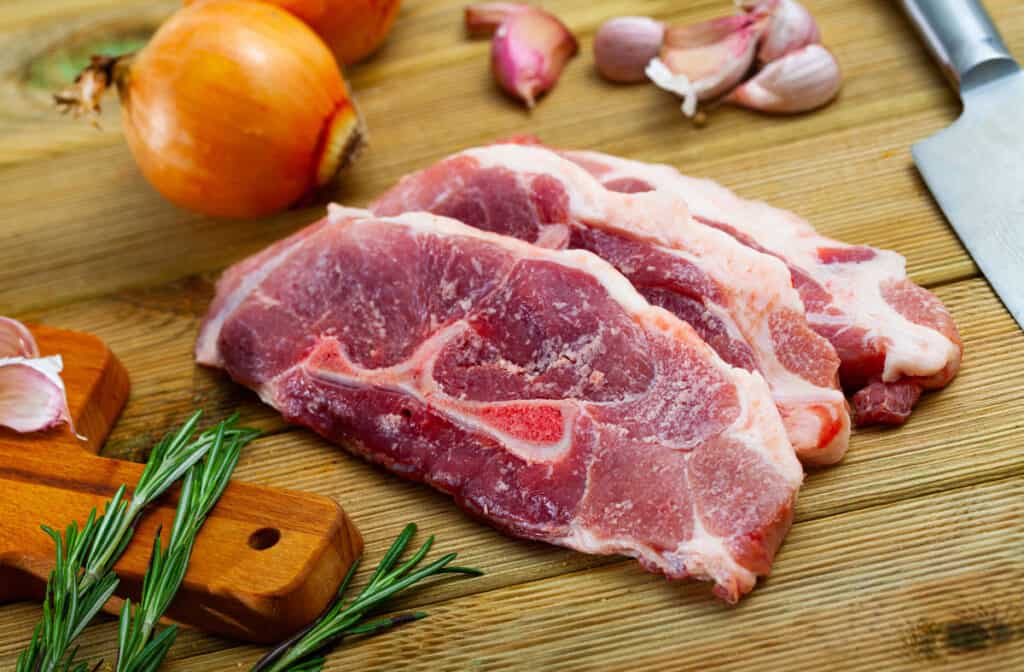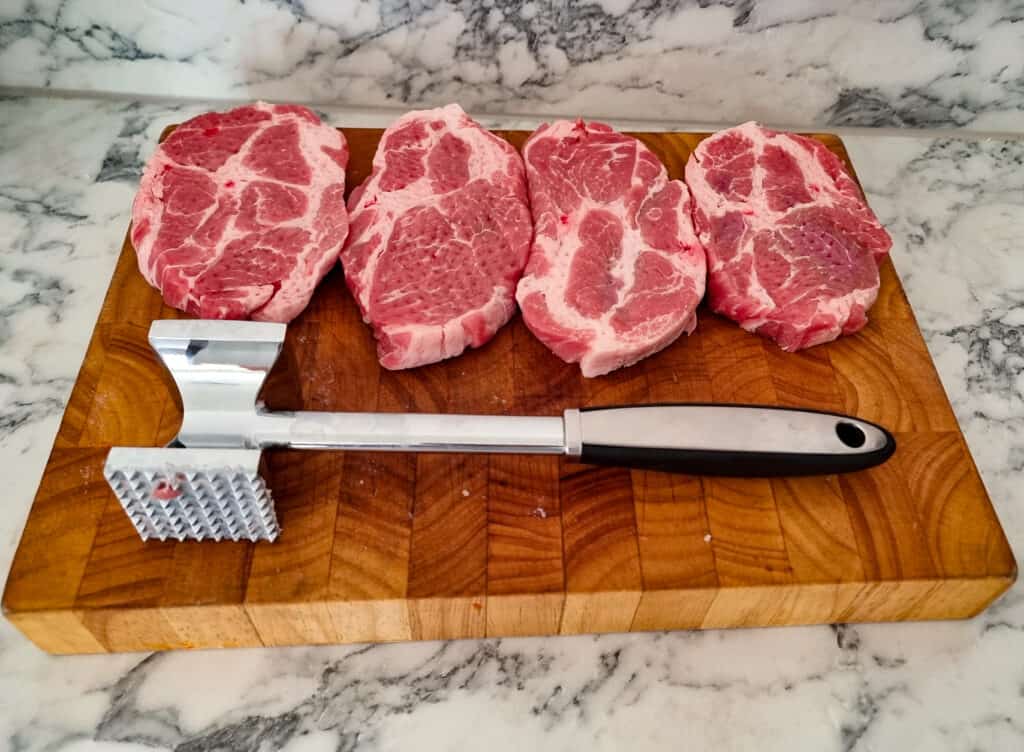When you see a package labeled “pork steaks,” what does that mean? Are these the same thing as pork chops, and if not, how do they differ? Our guide will tell you all you need to know about pork chops vs pork steak.
Pork Chops vs Pork Steak
Pork chops are typically cut from the loin primal of the hog. As such, they’re lean and tender, with minimal fat. Pork steaks, on the other hand, come from the shoulder, which is fatty and rich. Moreover, while chops are available boneless and bone-in, pork steaks are usually sold boneless.

Pork Chops: The Basics
Thanks to their lean texture and versatile nature, pork chops are an exceedingly popular cut of meat.
Chops are taken from the loin portion of the hog, which runs along the spine. The meat in this area doesn’t get a great deal of exercise, so it’s very tender and lean.
Note: Don’t confuse the pork loin with the pork tenderloin. The cuts are similar in that they don’t contain much fat, but the tenderloin has a very soft texture and overcooks quickly. It’s also much smaller, with a cylindrical appearance.
You can buy pork chops boneless or with the bone still attached. The boneless ones are usually thinner and cook quickly, while their bone-in counterparts are juicier and more flavorful. Both versions should have a thin strip of fat running along the outer edge.
Pork chops can be seasoned in a number of different ways. They’re excellent when grilled, smoked, roasted, braised, seared, or stuffed and baked in the oven. This flexibility is one of the reasons pork has been dubbed “the other white meat,” despite the fact that it’s classified as a red meat.
Pork Steaks: The Basics
Although it’s easy to understand why people would confuse pork steaks with pork chops, these are taken from different parts of the pig.
While the chops are most often taken from the loin primal, steaks are cut from the pork shoulder. This primal is located at the front of the animal and is tough and fatty, with plenty of connective tissue.

Although pork shoulder needs to cook for a long time when it’s sold whole, you can prepare pork steaks quickly over high heat. That’s because they’re carved into thin slices, usually measuring no more than 1 inch thick.
While we’re on the subject of carving, we should point out that while pork chops are widely available with the bone in, pork steaks are nearly always sold boneless. This has to do with the shape of the bones in the shoulder versus the bones near the loin.
A pork steak will have more natural pork flavor than a chop, owing to the higher fat content. For that reason, we prefer to season them simply, using a “dalmatian blend” of salt and pepper.
Pork Chops vs Pork Steaks: Breaking It Down
Cost
You can expect to spend more money when pork chops are on your shopping list. That’s partly because they’re more popular than pork steaks, but there are also other reasons.
For one thing, the pork shoulder yields more steaks for each pound of meat. The loin doesn’t have as much usable flesh, which puts the chops at a premium.
If you’re shopping on a budget and have your heart set on pork, consider purchasing steaks instead of chops. They’re easy to prepare when you know what to expect, and the meat is succulent and tasty.
Preparation
While pork chops can be delicious when they’re done right, there’s no way around the fact that they’re naturally drier than pork steaks. This difference will affect your preparation technique.
For pork chops, choose your favorite seasoning rub or marinade. If you opt to marinate the meat, make sure not to leave it in the mixture for longer than 24 hours, or it will turn to mush.
Set the grill to medium-high, then sear the chops for about 3 minutes per side. Once they’ve developed a nice brown crust, turn the heat down to medium and continue to cook until the internal temperature reaches 145 degrees Fahrenheit, about 6 to 7 minutes.
Let pork chops rest for 5 minutes before serving. Remember that bone-in chops will take a bit longer to cook—perhaps 9 to 10 minutes per side after browning.
To bring out the best qualities in your pork steaks, season them with salt and pepper, then grill them quickly over high heat for 2 to 3 minutes per side. At this point, the meat will be just cooked through, and the fat will imbue it with richness.

If inclement weather forces you to move the barbecue indoors, don’t worry. After seasoning the steaks, heat a cast iron skillet over medium-high, then add a dollop of neutral oil. Sear the steaks for 2 to 3 minutes per side, then increase the heat to high.
Add a splash of red wine, stirring to deglaze the pan, and bring the mixture to a simmer. Cook for an additional 5 to 8 minutes, or until the cooking liquid has reduced to form a velvety sauce.
Let the steaks rest for 5 minutes, then serve with the wine reduction.
Serving Temperature
Both pork chops and pork steaks should be served at 145 degrees Fahrenheit. At this point, the meat will be juicy and succulent, and still a bit pink in the middle. Pork served at 145 degrees is considered medium rare.
You can cook these cuts to 160 degrees if you prefer your meat on the well done side. The pork steaks should be able to handle the higher temperature, but we don’t recommend it for chops, as it will cause the leaner meat to toughen up.
Purchasing
It’s always better to procure your meat products from a reputable butcher. This is true whether you’re buying pork chops or pork steaks. That’s just one reason why we recommend forming good relationships with the employees at your local grocery store or meat market.
You’re in even better hands if you can purchase pork from a local pig farmer. They’ll be able to tell you everything about the product, including the dietary and exercise habits of the hogs.
If neither of these options are available where you live, at least try to buy pork that’s cut to order. Pre-packaged pork is fine in a pinch, but you want to make sure the meat is as fresh as possible.
Storage and Handling
Likewise, the cut of pork has little effect on the handling and storage techniques. You should always wash your hands before and after handling raw meat products, and make sure to clean any surface or utensil that’s come into contact with the uncooked pork.
Pork chops and steaks are best when prepared on the same day that you buy them. If this isn’t feasible, they should keep for up to 4 days in the fridge.
Keep the refrigerator temperature below 40 degrees at all times, and store meat on the bottom shelf of the fridge, toward the back. Follow these same guidelines for any cooked leftovers you might have on hand.
Freeze the pork if you won’t be able to cook it off within a few days. It should keep indefinitely when stored at 0 degrees or below, but it’s best to thaw and enjoy it within 6 months to a year.
Whether the pork is cooked or raw, never leave it out at room temperature for longer than 2 hours. This will attract hazardous bacteria, which could cause serious illness. In hot weather, refrigerate the meat within 1 hour.
Flavor
Pork steaks are the clear winner in this department. The shoulder packs a ton of flavor, thanks to its generous helping of fat. In fact, we often refer to slow-cooked pork shoulder as “meat candy.”
The loin isn’t as flavorful as the shoulder, so chops are relatively tasteless on their own. That said, we should point out that they do make a great canvas for bold spice blends, marinades, and sauces.
Texture
While we appreciate pork steak’s fine qualities, it’s not for everyone. Picky eaters, particularly children, are bound to prefer the drier, leaner texture of pork chops. These are also a better choice if you like your meat well done.

On the other hand, if you want a well-marbled cut, the pork steak is the way to go. Be forewarned that if the steaks are cut thicker than 1/2 inch or so, they’ll need more time on the grill—perhaps 7 to 8 minutes per side. Otherwise, the fat will be too chewy.
The Bottom Line
Meat terminology can be a confusing road to navigate. Since pork chops are so popular, it’s natural to assume that “pork steak” is just another term for the same cut.
Once you understand the difference, though, it’s not difficult to remember. And even if you buy the wrong cut by mistake, there’s a good chance that you’ll enjoy the results.
Best of luck, and happy grilling!

